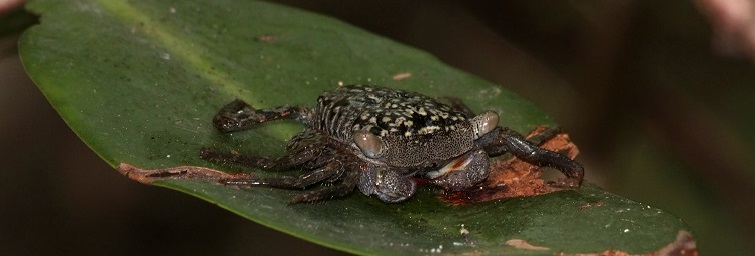Habitat
The Aratus pisonii, or mangrove tree crab has its own unique style of living, which makes up its surround habitat and environment, as well as its geographic location. It is found in mainly coastal regions throughout the Americas. Salinity, oxygen, and potential breeding locations are also factors in which contribute to habitat of the mangrove tree crab (Smithsonian, 2009).
The geographic range of the A. pisonii extends from Eastern Florida to Northern Brazil, the Pacific coasts ranging from Nicaragua to Peru, and in the Caribbean islands. Due to the mangrove tree crab being a tropical to subtropical species, it also inhabits warmer coastal regions throughout the Atlantic and Pacific Oceans. Mangrove locations are the major host to the mangrove tree crab however, which is how the crab got its common name. This evidence shows proof of the crab exhibiting a narrow tolerance for temperature (Smithsonian, 2009).
Aratus pisonii can be found in both aquatic and terrestrial environment. Although they spend most of their time in the canopies of trees they are forced to stay close to their water source at all times. The tree crab does not breathe oxygen similar to most crabs; therefore it gains its oxygen by maintaining a thin film of water on its branchiostegites at all times. Once the water dries up, the crab is forced to return to the water source to maintain the film. How close the water source is to the tree crab has a major impact on how long it can spend in the canopies of the tree and the terrestrial environment (Smithsonian, 2009).
In terms of migration, the mangrove tree crab commonly migrates vertically. During high tide, it spends all of its time in the canopies that provides shelter and safety. In the occurrence of low tide, it tends to enjoy time in the low land. This time is also used by the tree crab to occupy marine and estuary waters to release its larvae. Following the release of larvae, they tend to once again return to territory above the water line in the canopies (Smithsonian, 2009).
The average A. pisonii habitat ranges from 6 to 39oC (degrees Celsius) in temperature. It has also been found in saline waters with a range from 15 to 35 ppt (Parts-per notation). The crab’s tolerance to saline is most likely influenced by alterations in both its maturation and growth sizes. A. pisonii that reside in hypersaline lagoons tend to mature at a much smaller size than the crabs who spend more time in freshwater areas. In the lab, larvae of the tree crab have been cultured in both salinities of 25 and 34 ppt (Smithsonian, 2009).
The mangrove tree crab also uses its habitat in order to avoid predators. In the terrestrial environment, adult A. pisonii are able to cling to branches and bark to help avoid predators. They become vulnerable to birds and other mammals in this situation however. When they are in the aquatic environment, they are very vulnerable to fish and other aquatic species (Smithsonian, 2009).
In conclusion, Aratus pisonii tends to geographically reside mostly in coastal ranging along the ocean throughout both North and South America. Although they spend some time in their saline environments, they spend most of their time in the tree canopies of the terrestrial environment. The tree crab also uses its environment for important processes such as avoiding predation and successfully breathing oxygen (Smithsonian, 2009).
Go back to the Home page or learn about the Life History of this species.
